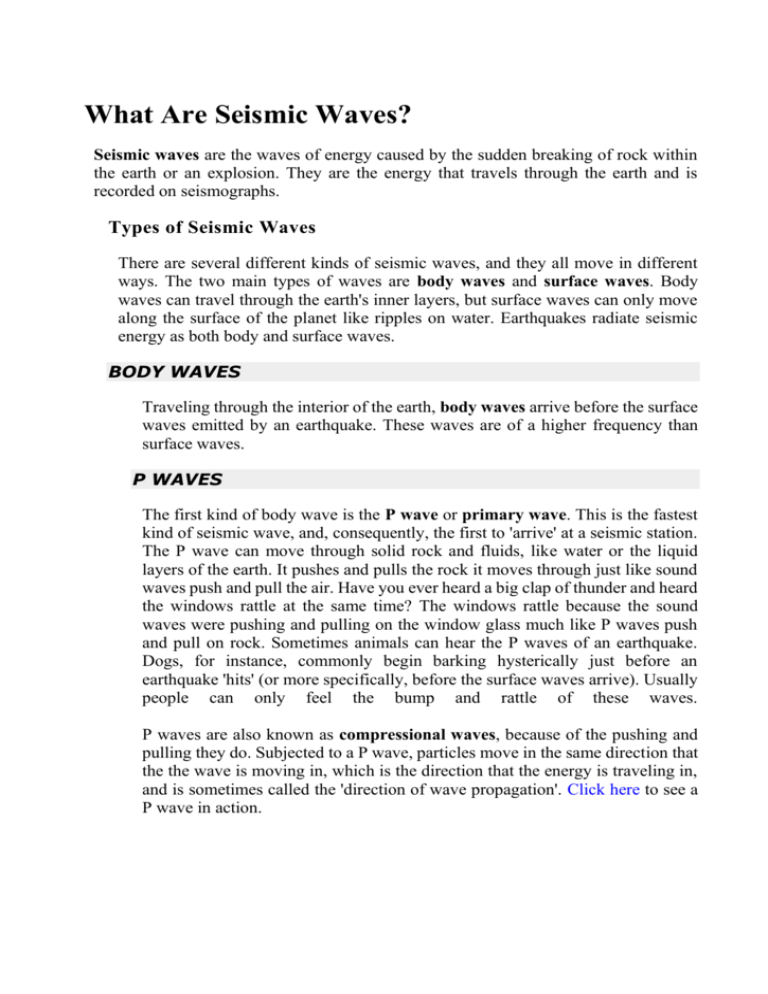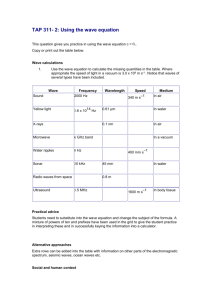What Are Seismic Waves?
advertisement

What Are Seismic Waves? Seismic waves are the waves of energy caused by the sudden breaking of rock within the earth or an explosion. They are the energy that travels through the earth and is recorded on seismographs. Types of Seismic Waves There are several different kinds of seismic waves, and they all move in different ways. The two main types of waves are body waves and surface waves. Body waves can travel through the earth's inner layers, but surface waves can only move along the surface of the planet like ripples on water. Earthquakes radiate seismic energy as both body and surface waves. BODY WAVES Traveling through the interior of the earth, body waves arrive before the surface waves emitted by an earthquake. These waves are of a higher frequency than surface waves. P WAVES The first kind of body wave is the P wave or primary wave. This is the fastest kind of seismic wave, and, consequently, the first to 'arrive' at a seismic station. The P wave can move through solid rock and fluids, like water or the liquid layers of the earth. It pushes and pulls the rock it moves through just like sound waves push and pull the air. Have you ever heard a big clap of thunder and heard the windows rattle at the same time? The windows rattle because the sound waves were pushing and pulling on the window glass much like P waves push and pull on rock. Sometimes animals can hear the P waves of an earthquake. Dogs, for instance, commonly begin barking hysterically just before an earthquake 'hits' (or more specifically, before the surface waves arrive). Usually people can only feel the bump and rattle of these waves. P waves are also known as compressional waves, because of the pushing and pulling they do. Subjected to a P wave, particles move in the same direction that the the wave is moving in, which is the direction that the energy is traveling in, and is sometimes called the 'direction of wave propagation'. Click here to see a P wave in action. FIGURE 1 - A P WAVE TRAVELS THROUGH A MEDIUM BY MEANS OF COMPRESSION AND DILATION. PARTICLES ARE REPRESENTED BY CUBES IN THIS MODEL. IMAGE Š2000-2006 LAWRENCE BRAILE, USED WITH PERMISSION. S WAVES The second type of body wave is the S wave or secondary wave, which is the second wave you feel in an earthquake. An S wave is slower than a P wave and can only move through solid rock, not through any liquid medium. It is this property of S waves that led seismologists to conclude that the Earth's outer core is a liquid. S waves move rock particles up and down, or side-to-side-perpindicular to the direction that the wave is traveling in (the direction of wave propagation). Click here to see a S wave in action. FIGURE 2 - AN S WAVE TRAVELS THROUGH A MEDIUM. PARTICLES ARE REPRESENTED BY CUBES IN THIS MODEL. IMAGE Š20002006 LAWRENCE BRAILE, USED WITH PERMISSION. If you'd like to try your hand at making your own P and S waves, try this little experiment. SURFACE WAVES Travelling only through the crust, surface waves are of a lower frequency than body waves, and are easily distinguished on a seismogram as a result. Though they arrive after body waves, it is surface waves that are almost enitrely responsible for the damage and destruction associated with earthquakes. This damage and the strength of the surface waves are reduced in deeper earthquakes. LOVE WAVES The first kind of surface wave is called a Love wave, named after A.E.H. Love, a British mathematician who worked out the mathematical model for this kind of wave in 1911. It's the fastest surface wave and moves the ground from side- to-side. Confined to the surface of the crust, Love waves produce entirely horizontal motion.Click here to see a Love wave in action. FIGURE 3 - A LOVE WAVE TRAVELS THROUGH A MEDIUM. PARTICLES ARE REPRESENTED BY CUBES IN THIS MODEL. IMAGE Š2000-2006 LAWRENCE BRAILE, USED WITH PERMISSION. RAYLEIGH WAVES The other kind of surface wave is the Rayleigh wave, named for John William Strutt, Lord Rayleigh, who mathematically predicted the existence of this kind of wave in 1885. A Rayleigh wave rolls along the ground just like a wave rolls across a lake or an ocean. Because it rolls, it moves the ground up and down, and side-to-side in the same direction that the wave is moving. Most of the shaking felt from an earthquake is due to the Rayleigh wave, which can be much larger than the other waves. Click here to see a Rayleigh wave in action. FIGURE 4 - A RAYLEIGH WAVE TRAVELS THROUGH A MEDIUM. PARTICLES ARE REPRESENTED BY CUBES IN THIS MODEL. IMAGE Š2000-2006 LAWRENCE BRAILE, USED WITH PERMISSION. Reference http://www.geo.mtu.edu/UPSeis/waves.html http://www.acs.psu.edu/drussell/Demos/waves/wavemotion.html








